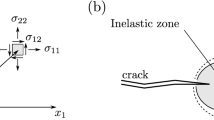Abstract
In this paper, an experimental analysis of the fracture parameters via the invariant J-integral for a cracked specimen made of wood is presented. The experimental test is realized using a sample made of Douglas fir loaded in opening mode. The sample geometry is a mix between the single edge notch and wedge splitting specimens, and the crack advances in the radial-longitudinal system, parallel to the wood rings. By using the optical mark tracking method, the displacement field evolution close to the crack tip is recorded during the test. The stress and strain fields are calculated using a finite element model generated from the experimental displacement fields. Further, the energy release rate is evaluated for different circular paths or crowns defined around the crack tip and for different loading values.








Similar content being viewed by others
References
Anderson TS (2005) Fracture mechanics. CRC Press, Boca Raton, FL
Barsoum RS (1976) On the use of isoparametric finite elements in linear fracture mechanics. Int J Numer Methods Eng 10:25–37
Bathe J, Klaus J (1982) Finite element procedures in engineering analysis. Prentice-Hall, Englewood Cliffs, NJ
Bretagne N, Valle V, Dupre JC (2005) Development of the marks tracking technique for strain field and volume variation measurements. NDT&E Int 38:290–298
Broek D (1974) Elementary engineering fracture mechanics. Kluwer, Dordrecht
Brühwiler E, Wittmann HS (1990) The wedge splitting test, a new method of performing stable fracture mechanics tests. Eng Fract Mech Special Issue Fract Damage Concr Rock 35(1–3):117–125
Budiansky B, Rice JR (1973) Conservation laws and energy-release rates. ASME J Appl Mech 40:201–203
Cherepanov GP (1962) The stress in a heterogeneous plate with slits, in Russian, Izvestia AN SSSR, OTN, Mekhan. I Mashin 1:131–137
Cherepanov GP (1979) Mechanics of brittle fracture. McGraw-Hill, New York
Gross B, Srawley JE (1965) Stress-intensity factors for single-edge-notch specimens in bending or combined bending and tension by boundary collocation of a stress function. NASA technical note
Guitard D (1987) Mechanics of wood material and composites (In French), Cepadues—Editions
Henshell RD, Shaw KG (1975) Crack tip elements are unnecessary. Int J Numer Methods Eng 9:495–507
Hild F, Roux S (2006) Measuring stress intensity factors with a camera: integrated digital image correlation (I-DIC). Comptes Rendus Mécanique 334(1):8–12
Hussain F, Nairn J, Muszynski L (2011) An experimental method for measurement of strain distribution between wood the flour particles and polymer matrix on micro-mechanical level. Mater Sci Eng, A 528:6072–6078
Lanczos C (1970) The variational principles of mechanics, 4th edn. Dover Publications, New York
Le Fichoux E (1998) Presentation and use of Castem 2000 (In French), ENSTA-LME
Miyauchi K, Murata K (2007) Strain-softening behavior of wood under tension perpendicular to the grain. J Wood Sci 53:463–469
Orosz K, Täljsten B (2009) Development of a new test method for mineral based composites—wedge splitting test. In: Alexander et al (eds) Concrete repair, rehabilitation and retrofitting II. Taylor & Francis Group, London
Orteu JJ (2009) 3-D computer vision in experimental mechanics. Opt Laser Eng 47:282–291
Post D (1993) Moire interferometry. In: Kobayashi AS (ed) Handbook on experimental mechanics. VCH Publishers Inc, New York, pp 297–405
Réthoré J, Roux S, Hild F (2008) Noise-robust stress intensity factor determination from kinematic field measurements. Eng Fract Mech 75:3763–3781
Réthoré J, Roux S, Hild F (2009) An extended and integrated digital image correlation technique applied to analysis fractured samples. Eur J Comput Mech 18:285–306
Rice JR (1968) A path independent integral and the approximate analysis of strain concentration by notches and cracks. J Appl Mech 35:379–386
Sanford RJ (1982) Fracture mechanics. ASTM STP 833
Smith I, Landis E, Gong M (2003) Fracture and fatigue in wood. Wiley, New York
Sutton MA, Wolters WJ, Peters WH, Ranson WF, McNeil SR (1983) Determination of displacements using an improved digital correlation method. Image Vision Comput 1(3):133–139
Sutton MA, Cheng MQ, Peters WH, Chao YJ, McNeill SR (1986) Application of an optimized digital correlation method to planar deformation analysis. Image Vision Comput 4(3):143–151
Sutton MA, Yan JH, Tiwari V, Schreier HW, Orteu JJ (2008) The effect of out-of-plane motion on 2D and 3D digital image correlation measurements. Opt Laser Eng 46(10):746–757
Vujanovic BD, Atanackovic TM (1930) An introduction to modern variational techniques in mechanics. Birkhäuser, Switzerland
Wells A, Post D (1958) The dynamic stress distribution surrounding a running crack—a photoelastic analysis. Proc Soc Exp Stress Anal 16:69–92
Yoneyama S, Morimoto Y, Takashi M (2003) Automatic determination method of stress intensity utilizing digital image correlation and nonlinear least squares. In: Abe M, Wu Z (eds) Structural health monitoring and intelligent infrastructure. Swet & Zeitlinger, Amsterdam, pp 1357–1424
Zienkiewicz OC, Taylor RL (2005) The finite element method for solid and structural mechanics. Elsevier Butterworth Heinemann, Amsterdam
Acknowledgments
Our sincere thanks are due to J. Cacault and Ing. H. M. Sebbah, who have contributed to and worked on the wood specimen and fixture systems preparation. Our sincere thanks are also due to the Photomechanics and Rheology team of Institut P’, who have contributed to marks tracking Deftac software development.
Author information
Authors and Affiliations
Corresponding author
Rights and permissions
About this article
Cite this article
Pop, O., Dubois, F. & Absi, J. J-integral evaluation in cracked wood specimen using the mark tracking method. Wood Sci Technol 47, 257–267 (2013). https://doi.org/10.1007/s00226-012-0488-5
Received:
Published:
Issue Date:
DOI: https://doi.org/10.1007/s00226-012-0488-5




